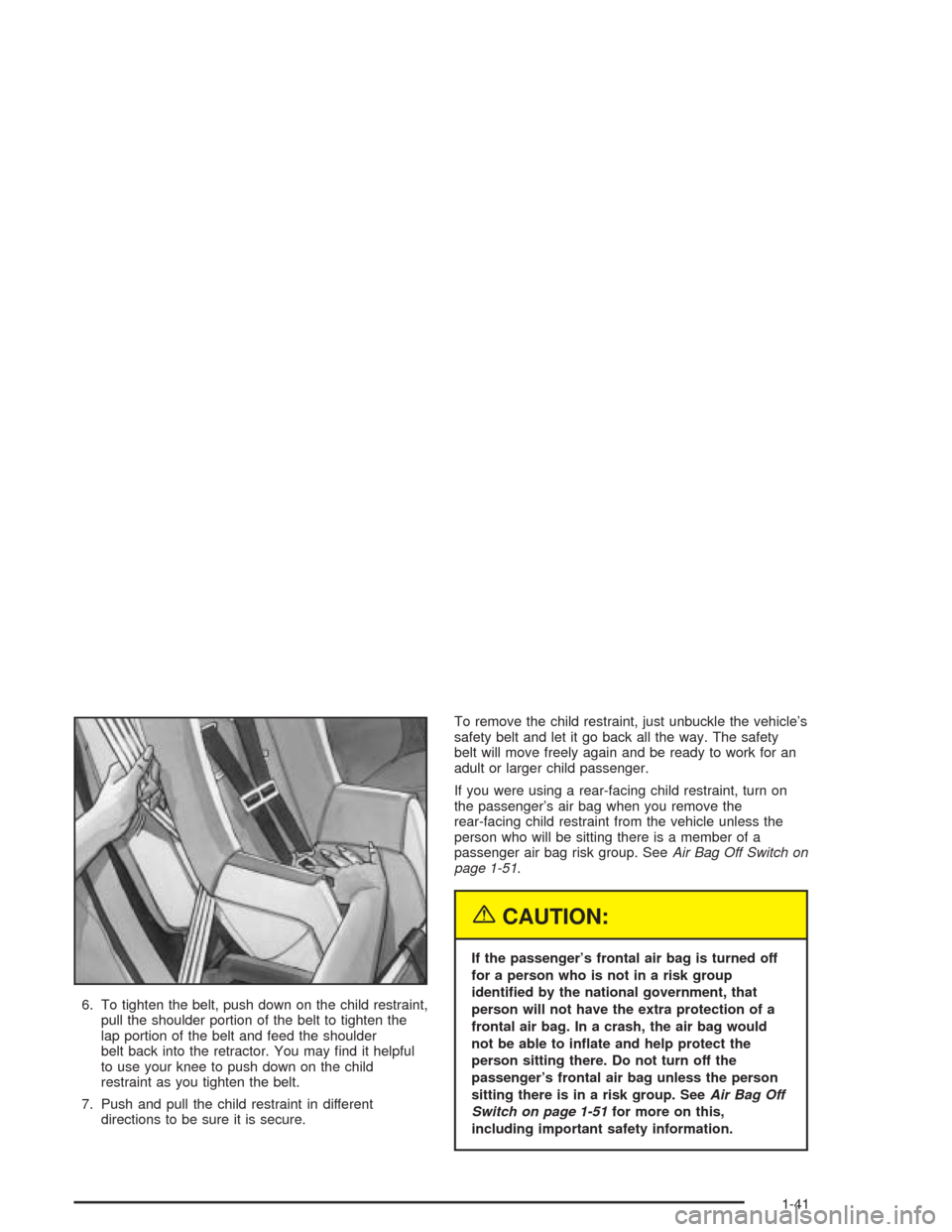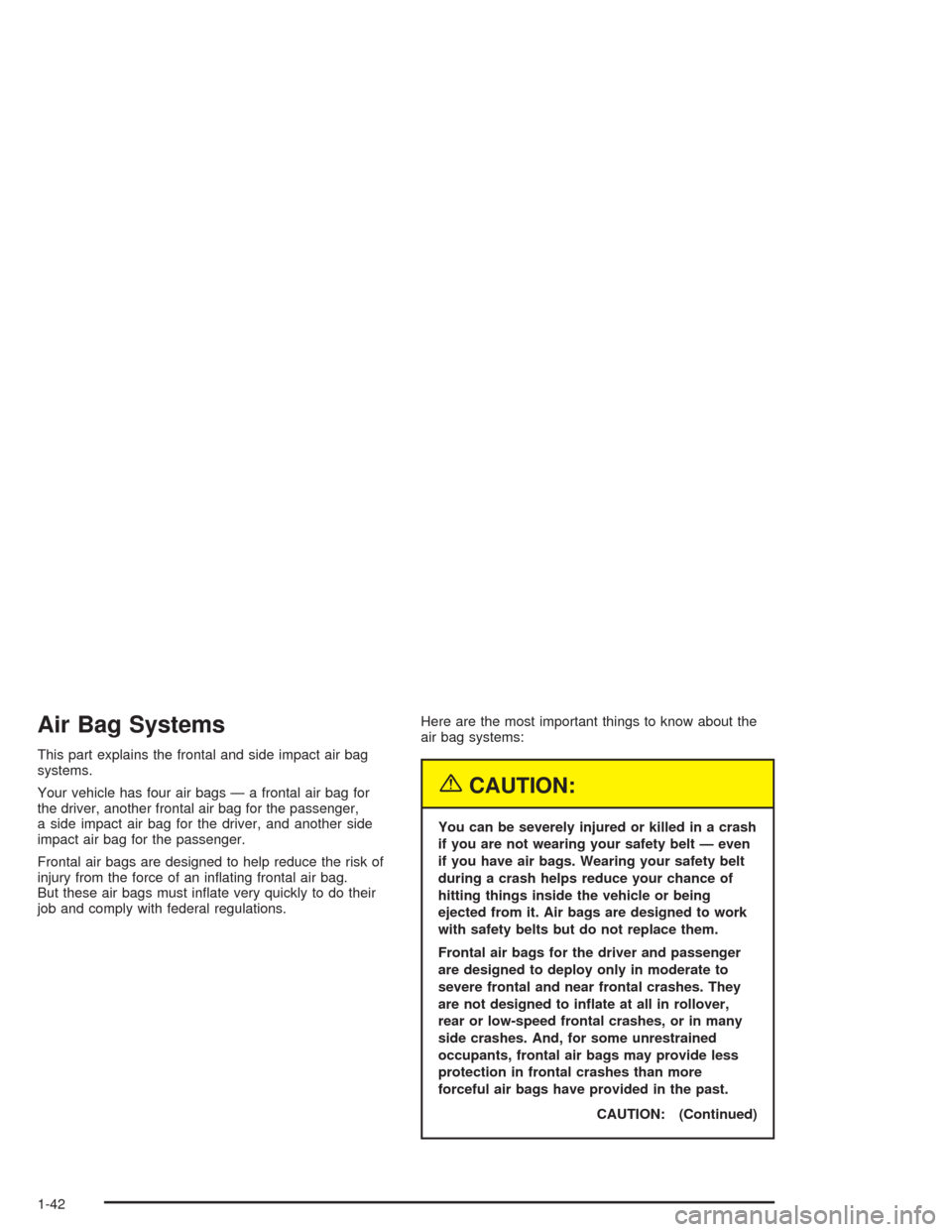Page 36 of 398

When choosing a child restraint, be sure the child
restraint is designed to be used in a vehicle. If it is, it
will have a label saying that it meets federal motor
vehicle safety standards.
Then follow the instructions for the restraint. You may
�nd these instructions on the restraint itself or in a
booklet, or both. These restraints use the belt system in
your vehicle, but the child also has to be secured
within the restraint to help reduce the chance of personal
injury. When securing an add-on child restraint, refer
to the instructions that come with the restraint which may
be on the restraint itself or in a booklet, or both, and
to this manual. The child restraint instructions are
important, so if they are not available, obtain a
replacement copy from the manufacturer.
The child restraint must be secured properly in the
passenger seat. If you want to secure a rear-facing child
restraint in the passenger’s seat, turn off the passenger’s
air bag. SeeAir Bag Off Switch on page 1-51and
Securing a Child Restraint in the Passenger Seat
Position on page 1-37for more on this, including
important safety information.
{CAUTION:
A child in a rear-facing child restraint can be
seriously injured or killed if the passenger’s air
bag in�ates. This is because the back of the
rear-facing child restraint would be very close
to the in�ating air bag. Be sure to turn off the
air bag before using a rear-facing child
restraint in the passenger seat position.
Keep in mind that an unsecured child restraint can move
around in a collision or sudden stop and injure people in
the vehicle. Be sure to properly secure any child restraint
in your vehicle — even when no child is in it.
Top Strap
Some child restraints have a top strap, or “top tether.”
It can help restrain the child restraint during a collision.
For it to work, a top strap must be properly anchored to
the vehicle. Some top strap-equipped child restraints are
designed for use with or without the top strap being
anchored. Others require the top strap always to be
anchored. Be sure to read and follow the instructions for
your child restraint. If yours requires that the top strap be
anchored, do not use the restraint unless it is anchored
properly.
1-30
Page 38 of 398
Top Strap Anchor Location
The anchor point for the
top strap is a loop located
at the back of the
passenger side seat.
Lower Anchorages and Top Tethers
for Children (LATCH System)
Your vehicle is equipped with the LATCH system. It is
located in the passenger seat.
This system, designed to make installation of child
restraints easier, does not use the vehicle’s safety belts.
Instead, it uses vehicle anchors (A, B) and child
restraint attachments to secure the restraints. Some
restraints also use another vehicle anchor to secure a
top tether strap (C).
1-32
Page 40 of 398
To assist you in locating the anchors for this child
restraint system, place your hand in a palm-up position
and reach up between the seat cushion and the
seatback.
{CAUTION:
If a LATCH-type child restraint is not attached
to its anchorage points, the restraint will not
be able to protect the child correctly. In a
crash, the child could be seriously injured or
killed. Make sure that a LATCH-type child
restraint is properly installed using the
anchorage points, or use the vehicle’s safety
belts to secure the restraint, following the
instructions that came with that restraint, and
also the instructions in this manual.
Securing a Child Restraint Designed
for the LATCH System
Your vehicle has a passenger air bag. There is an air
bag off switch in the glove box you can use to turn
off the passenger’s air bag. SeeAir Bag Off Switch on
page 1-51for more on this, including important
safety information.
1-34
Page 45 of 398

{CAUTION:
If the air bag readiness light ever comes on
when you have turned off the passenger’s
frontal air bag, it means that something may
be wrong with the air bag system. The
passenger’s frontal air bag could in�ate even
though the switch is off. If this ever happens,
do not let anyone whom the national
government has identi�ed as a member of a
passenger air bag risk group sit in the
passenger’s position (for example, do not
secure a rear-facing child restraint in your
vehicle) until you have your vehicle serviced.
SeeAir Bag Off Switch on page 1-51.
If your child restraint is equipped with the LATCH
system, seeLower Anchorages and Top Tethers for
Children (LATCH System) on page 1-32. SeeTop Strap
on page 1-30if the child restraint has one.If your child restraint does not have the LATCH system,
you will be using the lap-shoulder belt. Be sure to
follow the instructions that came with the child restraint.
Secure the child in the child restraint when and as
the instructions say.
1. Your vehicle has a passenger’s air bag. If you are
using a rear-facing child restraint in this seat, make
sure the air bag is turned off. SeeAir Bag Off
Switch on page 1-51. If your child restraint is
forward-facing, always move the seat as far back
as it will go before securing it in this seat. See
Power Seats on page 1-2.
2. Put the child restraint on the seat.
3. Pick up the latch plate, and run the lap and shoulder
portions of the vehicle’s safety belt through or
around the restraint. The child restraint instructions
will show you how.
1-39
Page 46 of 398
4. Buckle the belt. Make sure the release button is
positioned so you would be able to unbuckle the
safety belt quickly if you ever had to.5. Pull the rest of the shoulder belt all the way out of
the retractor to set the lock.
1-40
Page 47 of 398

6. To tighten the belt, push down on the child restraint,
pull the shoulder portion of the belt to tighten the
lap portion of the belt and feed the shoulder
belt back into the retractor. You may �nd it helpful
to use your knee to push down on the child
restraint as you tighten the belt.
7. Push and pull the child restraint in different
directions to be sure it is secure.To remove the child restraint, just unbuckle the vehicle’s
safety belt and let it go back all the way. The safety
belt will move freely again and be ready to work for an
adult or larger child passenger.
If you were using a rear-facing child restraint, turn on
the passenger’s air bag when you remove the
rear-facing child restraint from the vehicle unless the
person who will be sitting there is a member of a
passenger air bag risk group. SeeAir Bag Off Switch on
page 1-51.
{CAUTION:
If the passenger’s frontal air bag is turned off
for a person who is not in a risk group
identi�ed by the national government, that
person will not have the extra protection of a
frontal air bag. In a crash, the air bag would
not be able to in�ate and help protect the
person sitting there. Do not turn off the
passenger’s frontal air bag unless the person
sitting there is in a risk group. SeeAir Bag Off
Switch on page 1-51for more on this,
including important safety information.
1-41
Page 48 of 398

Air Bag Systems
This part explains the frontal and side impact air bag
systems.
Your vehicle has four air bags — a frontal air bag for
the driver, another frontal air bag for the passenger,
a side impact air bag for the driver, and another side
impact air bag for the passenger.
Frontal air bags are designed to help reduce the risk of
injury from the force of an in�ating frontal air bag.
But these air bags must in�ate very quickly to do their
job and comply with federal regulations.Here are the most important things to know about the
air bag systems:
{CAUTION:
You can be severely injured or killed in a crash
if you are not wearing your safety belt — even
if you have air bags. Wearing your safety belt
during a crash helps reduce your chance of
hitting things inside the vehicle or being
ejected from it. Air bags are designed to work
with safety belts but do not replace them.
Frontal air bags for the driver and passenger
are designed to deploy only in moderate to
severe frontal and near frontal crashes. They
are not designed to in�ate at all in rollover,
rear or low-speed frontal crashes, or in many
side crashes. And, for some unrestrained
occupants, frontal air bags may provide less
protection in frontal crashes than more
forceful air bags have provided in the past.
CAUTION: (Continued)
1-42
Page 49 of 398
CAUTION: (Continued)
The side impact air bags for the driver and
passenger are designed to in�ate only in
moderate to severe crashes where something
hits the side of your vehicle. They are not
designed to in�ate in frontal, in rollover or in
rear crashes.
Everyone in your vehicle should wear a safety
belt properly — whether or not there is an air
bag for that person.
{CAUTION:
Both frontal and side impact air bags in�ate
with great force, faster than the blink of an
eye. If you are too close to an in�ating air bag,
as you would be if you were leaning forward, it
could seriously injure you. Safety belts help
keep you in position for air bag in�ation before
and during a crash. Always wear your safety
belt, even with frontal air bags. The driver
should sit as far back as possible while still
maintaining control of the vehicle. Front
occupants should not lean on or sleep against
the door.
1-43